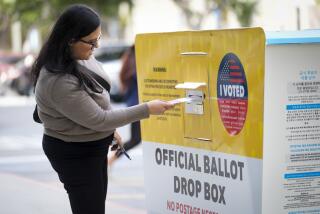Litigation May Reshape City Government : Charter: Dispute reignites power struggle between the council and mayor-appointed commissions.
- Share via
The litigation over the future of Police Chief Daryl F. Gates has raised fundamental questions about the structure of Los Angeles city government that could reshape the city’s power structure for years to come, city officials said Monday.
“The legal question is far-reaching,” said Jane Ellison, legal counsel for Mayor Tom Bradley. “The dispute comes down to who is responsible for the supervision of the Police Department and instructing the chief of police.”
At its heart, officials said, the dispute is an unprecedented power struggle between the Los Angeles City Council and Police Commission, which is appointed by Bradley.
Under the City Charter, the council does not have the authority to overrule a commission decision, a circumstance that has long irked many council members. Last week’s vote by the Police Commission to place Gates on a 60-day leave so infuriated the council that it scrambled for a way to thwart the commission’s action.
The council found its answer in a creative legal maneuver. Invoking its power to settle all lawsuits against the city, the council voted 10-3 to reinstate Gates as part of a settlement of a lawsuit he was expected to file.
In essence, the council was attempting to do “through the back door what it cannot do through the front door,” one commission member said.
“What a scholar of the charter would say is that the City Council can’t, through the threat of litigation, obtain powers it doesn’t already have,” Ellison said.
If the council succeeds, much of the power of the city’s executive branch would be shifted to the council, the legislative branch, officials said.
To City Council President John Ferraro, the issue is simple. “The City Council is the governing body of the city of Los Angeles and we want to settle a lawsuit,” Ferraro said. In reinstating Gates, the council was exercising its responsibility to look out for the financial welfare of the city, he said.
“What would it cost us if Daryl Gates won a lawsuit,” Ferraro said, estimating that the city stands to lose hundreds of thousands of dollars. “We are the City Council. We have the authority to settle lawsuits.”
Los Angeles has been operating under a mayor-council-commission form of government since the City Charter was last redrafted in 1925. Most large American cities, including New York and Chicago, are run by mayors and councils alone, with the mayor being the chief administrator who is responsible for the operations of city departments.
In Los Angeles, the mayor is a step removed from city operations and must exert his influence through the 35 commissions that oversee city departments and agencies. The mayor appoints the panels, which generally have five members and must be approved by the City Council. The council rarely rejects the mayor’s choices. Most commissioners receive nominal payment for their services.
In theory, the commissions overseeing departments and agencies are supposed to act as independent citizen panels that review practices and set policies. In practice, many appointees are close allies of the mayor who help to put his plans and programs in place. A number of key commissioners, including Police Commission President Dan Garcia, are major political fund-raisers for the mayor.
The cumbersome commission system was the result of a strong political movement in California in the early 1900s aimed at taking politics out of the hands of professional politicians and putting it in the hands of the people. Voter initiatives, recalls and nonpartisan local elections also were results of the 1910 movement led by then-California Gov. Hiram Johnson.
Throughout the state, local governments adopted variations of the commission form of government, which had become the darling of reformers nationally. The hallmark of the movement was the division of political power. The imposition of commissions was designed to weaken the power of the mayor and City Council.
The system was reaffirmed with charter amendments in 1935 and 1937, when corruption scandals prompted changes that increased the independence and power of the police chief.
At stake in the Gates litigation, said Police Commissioner Melanie Lomax, is the “ongoing viability of the Police Commission,” and “whether or not the commission has the authority to take civilian control of this department in this atmosphere.”
So seriously do the commissioners take the threat, she said, that they are considering “en masse” resignations. With the commission in a “very tenuous situation already,” Lomax said, “I just don’t know whether under these circumstances it would be something I would be interested in continuing.”
The city’s charter spells out a weak-mayor, strong-council form of government, said Councilwoman Joan Milke Flores, who has long been pushing for charter reforms that would give the council greater authority.
The problem, she said, is that the city is supposed to have a strong council “but we’re prohibited from really governing.” Flores has for years been pushing for a charter amendment that would allow the City Council to overrule decisions of commissions, a power the council does not now have.
Such a charter amendment will be on the June ballot. It would give the council the power to settle matters such as the Gates dispute without going to court.
“If we are to truly be the governing body of the city, we really need to have the authority,” she said.
Ellison, the mayor’s lawyer, said the fact that the council is seeking a charter amendment is an admission that the council knows that it lacks the power to reinstate Gates.
More to Read
Sign up for Essential California
The most important California stories and recommendations in your inbox every morning.
You may occasionally receive promotional content from the Los Angeles Times.










